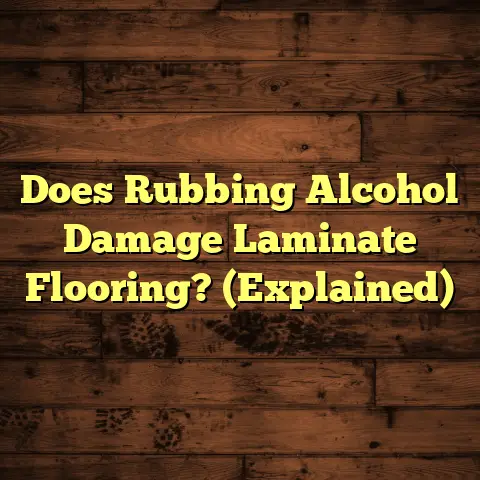How To Waterproof Garage Floor? (1-Day Seal!)
As a flooring contractor for over 15 years, I’ve seen firsthand the damage water can wreak on a garage floor.
It’s not pretty.
That’s why I’m so passionate about helping people waterproof their garages.
And guess what?
It doesn’t have to be a huge, expensive project.
With the 1-day seal method, you can protect your garage floor in a single weekend!
Let’s dive in and learn how.
Introduction
Let’s face it: the garage is often the forgotten zone of our homes.
But think about it: it houses your vehicles, tools, sports equipment, and maybe even serves as a workshop.
All that is vulnerable to water damage!
I’ve seen garages with mold creeping up the walls, concrete crumbling, and stored items ruined due to moisture.
The culprit?
A lack of proper waterproofing.
Water infiltration can lead to:
- Mold and mildew growth.
- Structural damage to the concrete floor.
- Rust and corrosion of stored items.
- Unpleasant odors.
The good news?
Waterproofing your garage floor is a proactive step that offers a ton of benefits:
- Prolonged Durability: A waterproof barrier protects the concrete from water damage, extending its lifespan.
- Improved Aesthetics: Say goodbye to stains, cracks, and discoloration caused by moisture.
- Enhanced Safety: A dry floor is a safer floor, reducing the risk of slips and falls.
And with a 1-day seal, it’s totally achievable!
Section 1: Understanding Garage Floor Waterproofing
So, what exactly is waterproofing?
Simply put, it’s creating an impermeable barrier that prevents water from penetrating the surface.
Think of it like a raincoat for your garage floor.
Why is it so important?
Concrete, while durable, is porous.
It readily absorbs water, which can then lead to a host of problems.
The type of garage floor you have plays a role, too.
Here’s a quick rundown:
- Concrete: The most common type. Porous and susceptible to water damage if unprotected.
- Epoxy-Coated Concrete: Offers some water resistance, but a dedicated waterproofing sealant provides an extra layer of protection, especially at the seams.
- Painted Concrete: Paint alone is not a waterproofing solution! It can peel and crack, allowing water to seep through.
Where does the water come from?
Garages are exposed to a variety of water sources:
- Rain and Snowmelt: Tracked in by vehicles or blown in through open doors.
- Plumbing Leaks: A leaky water heater or washing machine can cause significant water damage.
- Groundwater: Moisture can seep up through the concrete slab, especially in areas with high water tables.
Think about the last time you drove into your garage with a snowy car.
That melting snow is now sitting on your concrete floor, slowly seeping in.
Over time, this constant exposure can cause serious damage.
Section 2: Preparing for Waterproofing
Okay, you’re convinced that waterproofing is a must.
Now, let’s get down to the nitty-gritty of preparing your garage floor.
This is arguably the most important step!
A properly prepared surface ensures that the sealant adheres correctly and provides long-lasting protection.
Tools and Materials Checklist:
- Waterproof sealant (appropriate for concrete)
- Concrete cleaner/degreaser
- Stiff-bristled brush or scrub brush
- Shop vacuum
- Concrete patch (if needed)
- Trowel or putty knife (for patching)
- Painter’s tape
- Paint roller or sprayer (depending on sealant)
- Paint tray
- Gloves
- Safety glasses
- Respirator or mask
Step-by-Step Preparation Guide:
-
Clearing the Space: This seems obvious, but it’s crucial. Remove everything from your garage. Trust me, you don’t want to be working around clutter.
-
Cleaning the Floor: This is where the elbow grease comes in. You need to remove all dirt, oil, grease, and debris from the concrete surface.
- Degreasing: Apply a concrete degreaser according to the manufacturer’s instructions. Let it sit for the recommended time, then scrub vigorously with a stiff-bristled brush.
- Scrubbing: Use a concrete cleaner and scrub the entire floor. Pay special attention to any stained or heavily soiled areas.
- Rinsing: Rinse the floor thoroughly with clean water.
- Drying: Allow the floor to dry completely. This may take several hours or even overnight, depending on the humidity.
-
Inspecting for Cracks or Damage: Once the floor is clean and dry, carefully inspect it for any cracks, chips, or other damage.
- Small Cracks: Hairline cracks can be filled with a concrete crack filler using a putty knife.
- Larger Cracks: Wider cracks may require a concrete patching compound. Follow the manufacturer’s instructions for application and curing.
- Pitting or Spalling: If you have significant pitting or spalling (surface flaking), you may need to apply a concrete resurfacing compound.
Pro Tip: I often use a wire brush to remove any loose concrete around cracks before applying the filler. This helps the filler adhere better.
-
Etching (Optional): Some sealants require concrete etching to improve adhesion. Etching opens up the pores of the concrete, allowing the sealant to penetrate deeper.
- Muriatic Acid: If etching is required, follow the manufacturer’s instructions carefully. Muriatic acid is a harsh chemical, so wear appropriate safety gear (gloves, safety glasses, respirator).
- Rinsing: Rinse the floor thoroughly after etching to remove all traces of acid.
- Neutralizing: Some etching solutions require neutralization before applying the sealant.
-
Taping: Use painter’s tape to mask off any areas you don’t want to seal, such as walls, doors, or drains.
Section 3: Choosing the Right Waterproofing Sealant
With the floor prepped, it’s time to choose your weapon of choice: the waterproofing sealant.
There are many options on the market, but for a 1-day seal, you’ll want to focus on products designed for quick application and curing.
Types of Waterproofing Sealants:
- Acrylic Sealants: Water-based, easy to apply, and relatively inexpensive. They offer good water resistance but may not be as durable as other options.
- Epoxy Sealants: Two-part systems that offer excellent durability and chemical resistance. They are more expensive than acrylics and require careful mixing, but they provide a tough, long-lasting finish.
- Polyurethane Sealants: Known for their flexibility and resistance to abrasion. They are a good choice for garages that experience heavy traffic or extreme temperatures.
- Siloxane Sealants: Penetrating sealants that react with the concrete to create a waterproof barrier. They are invisible and don’t change the appearance of the concrete.
Water-Based vs. Solvent-Based Sealants:
| Feature | Water-Based Sealants | Solvent-Based Sealants |
|---|---|---|
| Composition | Water is the primary solvent | Organic solvents are used |
| Odor | Low odor | Strong odor |
| VOCs | Low VOCs (Volatile Organic Compounds) | High VOCs |
| Clean-up | Easy clean-up with soap and water | Requires solvents for clean-up |
| Durability | Generally less durable than solvent-based | Generally more durable than water-based |
| Application | Easier to apply | Requires more ventilation and safety precautions |
| Drying Time | Can be longer drying time | Faster drying time |
| Environmental Impact | More environmentally friendly | Less environmentally friendly |
I generally recommend water-based acrylic or polyurethane sealants for DIYers looking for a 1-day seal.
They are easier to work with and have lower VOCs, making them safer to use.
Reputable Brands:
- Quikrete: Offers a range of concrete sealers, including water-based acrylics and polyurethanes.
- Rust-Oleum: Known for its durable coatings and sealants, including epoxy and concrete sealers.
- Thompsons WaterSeal: Specializes in waterproofing products for various surfaces, including concrete.
Choosing the Right Sealant:
Consider these factors when selecting a sealant:
- Type of Garage Floor: Concrete, epoxy-coated, or painted.
- Climate: Temperature fluctuations, freeze-thaw cycles.
- Traffic: Foot traffic, vehicle traffic, heavy equipment.
- Chemical Resistance: Exposure to oil, gasoline, or other chemicals.
- Ease of Application: Your DIY skill level.
- Drying Time: How quickly you need to use the garage.
Pro Tip: Read the product reviews! See what other homeowners have to say about their experience with the sealant.
Section 4: The 1-Day Seal Application Process
Alright, you’ve got your sealant, you’ve prepped the floor, now it’s time for the main event: applying the 1-day seal.
Follow these steps carefully for a professional-looking, waterproof finish.
Safety Precautions:
- Ventilation: Ensure adequate ventilation in the garage. Open doors and windows to allow fresh air to circulate.
- Protective Gear: Wear gloves, safety glasses, and a respirator or mask to protect yourself from fumes and splashes.
- Skin Protection: Wear long sleeves and pants to prevent skin contact with the sealant.
Application Temperature and Conditions:
- Temperature: Most sealants require a minimum temperature of 50°F (10°C) to cure properly. Check the manufacturer’s instructions for specific temperature requirements.
- Humidity: Avoid applying sealant on days with high humidity, as this can affect the curing process.
- Weather: Don’t apply sealant if rain is expected within 24 hours.
Mixing the Sealant (If Applicable):
- Two-Part Systems: Epoxy sealants typically come in two parts that need to be mixed together. Follow the manufacturer’s instructions carefully, paying attention to the mixing ratio and mixing time.
- Stirring: Stir the sealant thoroughly before application, even if it’s a one-part system. This ensures that the solids are evenly distributed.
Application Technique:
- Brush: Use a brush for cutting in around edges and corners.
- Roller: Use a paint roller for applying the sealant to the main floor area. Choose a roller with a nap appropriate for the sealant and the texture of the concrete.
- Sprayer: A sprayer can be used for applying thin, even coats of sealant. This is a good option for large garages.
Applying the Sealant:
- First Coat: Apply a thin, even coat of sealant to the entire floor, starting in one corner and working your way across. Overlap each stroke slightly to ensure complete coverage.
- Drying Time: Allow the first coat to dry completely according to the manufacturer’s instructions. This may take several hours.
- Second Coat (Optional): Apply a second coat of sealant for added protection and durability. Apply the second coat in the opposite direction of the first coat.
- Drying Time: Allow the second coat to dry completely before allowing foot or vehicle traffic.
Coverage:
- Calculate Square Footage: Measure the length and width of your garage and multiply them together to get the square footage.
- Check Product Label: The sealant label will indicate the coverage rate (square feet per gallon).
- Estimate Amount Needed: Divide the square footage of your garage by the coverage rate to determine how many gallons of sealant you need.
Pro Tips:
- Don’t Apply Too Thick: Applying too much sealant can cause it to bubble or peel.
- Work in Sections: If you have a large garage, work in sections to prevent the sealant from drying out before you can apply it evenly.
- Back-Rolling: After applying the sealant with a roller, go back over it with a dry roller to remove any excess sealant and ensure an even coat.
Section 5: Curing and Maintenance
The sealant is applied, and your garage floor is starting to look fantastic!
But the job’s not quite done yet.
Proper curing is essential for ensuring that the sealant reaches its full strength and provides long-lasting protection.
Curing Process:
- Drying Time: Refer to the manufacturer’s instructions for the recommended drying time. This can vary depending on the type of sealant and the environmental conditions.
- Foot Traffic: Avoid walking on the sealed floor until it is fully cured.
- Vehicle Traffic: Wait even longer before parking vehicles on the sealed floor. Check the manufacturer’s instructions for specific recommendations.
Factors Affecting Curing Time:
- Temperature: Lower temperatures can slow down the curing process.
- Humidity: High humidity can also affect curing time.
- Ventilation: Good ventilation can help speed up the curing process.
Ensuring Optimal Results:
- Keep the Garage Door Open: Open the garage door to allow for good ventilation.
- Use Fans: Use fans to circulate air and speed up the drying process.
- Avoid Moisture: Keep the floor dry during the curing process.
Maintenance Tips:
- Regular Cleaning: Sweep or vacuum the floor regularly to remove dirt and debris.
- Spot Cleaning: Clean up spills immediately to prevent staining.
- Mild Detergent: Use a mild detergent and water to clean the floor. Avoid harsh chemicals or abrasive cleaners.
- Annual Inspection: Inspect the floor annually for any signs of damage, such as cracks or peeling.
- Reapplication: Reapply the sealant every few years to maintain its waterproof protection.
Pro Tip: Place mats under vehicles to protect the sealed floor from oil and other fluids.
Section 6: Troubleshooting Common Issues
Even with careful preparation and application, problems can sometimes arise.
Here are some common issues and how to fix them:
-
Bubbling: Bubbling can occur if the sealant is applied too thick or if the concrete is not properly prepared.
- Solution: Scrape off the bubbles with a putty knife and reapply a thin coat of sealant.
-
Peeling: Peeling can occur if the sealant does not adhere properly to the concrete.
- Solution: Scrape off the peeling sealant and re-etch the concrete before reapplying the sealant.
-
Uneven Application: Uneven application can result in a blotchy or inconsistent finish.
- Solution: Apply a second coat of sealant to even out the finish.
-
Tackiness: If the sealant remains tacky after the recommended drying time, it may be due to high humidity or low temperatures.
- Solution: Increase ventilation and allow more time for the sealant to cure.
-
Staining: Staining can occur if spills are not cleaned up promptly.
- Solution: Try cleaning the stain with a mild detergent and water. If the stain persists, you may need to use a concrete stain remover.
Pro Tip: Always test any cleaning solution or stain remover in an inconspicuous area before applying it to the entire floor.
Conclusion
Waterproofing your garage floor is an investment that pays off in the long run.
By following the steps outlined in this article, you can protect your garage from water damage, extend the life of your concrete, and create a safer, more enjoyable space.
The 1-day seal method makes it easy to achieve professional-looking results without breaking the bank or spending weeks on the project.
So, what are you waiting for?
Grab your tools, choose your sealant, and get ready to transform your garage floor into a waterproof oasis!
You’ll be amazed at the difference it makes. And I know you can do it!





